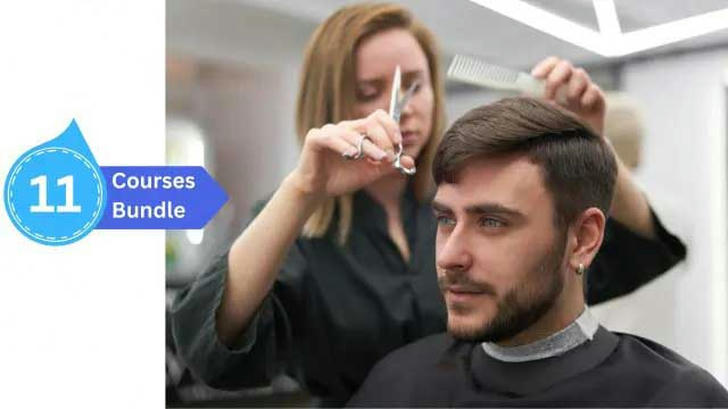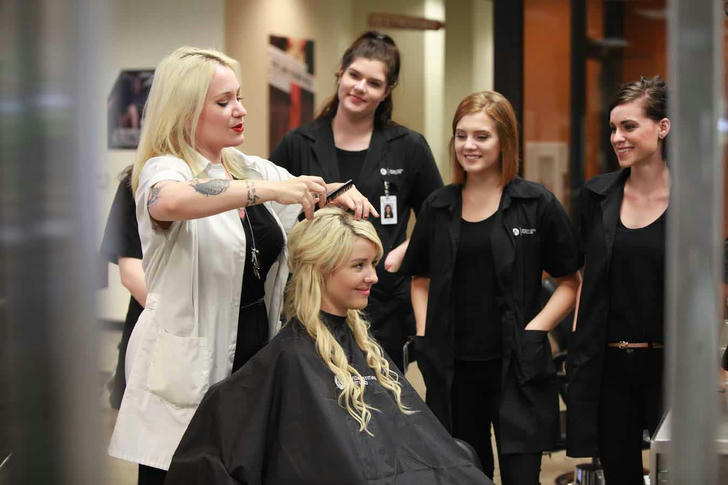From Scissors to Success: A Complete Guide to Hairdressing Courses in the U.S.
Flexible schedules available / Completion of approved courses leads to certification or licensing / No experience required / The median annual wage for hairdressers, hairstylists, and cosmetologists is approximately $35,420, with a median hourly wage of $16.95
Are you passionate about hairstyling and dream of turning that passion into a rewarding career? Hairdressing is a vibrant and creative profession that combines artistry with technical skills. Whether you want to become a professional hairstylist, barber, or salon owner, enrolling in a hairdressing course is the first step toward mastering the craft.

Why Take a Professional Hairdressing Course?
Hairdressing isn’t just about cutting hair—it’s about understanding chemistry (for color treatments), mastering precision (for cuts and styling), and building client relationships. Professional courses provide hands-on training, industry insights, and credentials that are often required to get licensed and work legally in most states. According to the U.S. Bureau of Labor Statistics, employment in personal care services like hairdressing is projected to grow 8% from 2022 to 2032, faster than the average for all occupations. This growth, combined with the flexibility of freelance or salon-based careers, makes hairdressing a rewarding path.
Hairdressing courses vary in length and depth. Some are short-term workshops lasting a few weeks, while others are comprehensive diploma or certificate programs that take several months to complete. Many schools offer flexible schedules, including part-time and online options, to fit your lifestyle.
Why Take a Hairdressing Course?
Gain Professional Skills: Learning from experienced instructors helps you develop the technical skills and confidence needed to work on real clients.
Get Certified: Completing a recognized course often leads to a certification or license, which is required to work legally in many states.
Build a Portfolio: Practical training allows you to create a portfolio of your work, showcasing your styles and techniques to future employers or clients.
Choosing the Right School
1. International Career Institute (ICI) – Online Hairdressing Courses
Format: Fully online, distance learning
Flexibility: Study anytime, anywhere at your own pace, ideal if you have work or family commitments
Cost: Generally lower than traditional in-person programs; payment plans available
Qualification: Diploma or Advanced Diploma in Hairdressing, accredited by the International Association of Private Career Colleges (IAPCC)
Course content: Covers practical skills such as cutting, coloring, styling, chemical treatments, client consultation, and salon management
Ideal for: Beginners or those already in the industry wanting to upgrade skills without disrupting daily life
More info: This is a very budget-friendly option that removes travel and scheduling barriers.
2. Penrose Academy (Phoenix, AZ) – Hair Hybrid Program
Format: Hybrid (combines on-campus hands-on training with online coursework)
Flexibility: Offers two schedules—full-time 4 days/week (30 weeks) or part-time 2 days/week (50 weeks)
Qualification: Licensure program preparing students to become licensed hair stylists
Benefits: Flexible pacing to fit busy lifestyles; interactive online platform; professional development curriculum included
Cost: Competitive tuition with options to tour and consult before enrolling
Ideal for: Those wanting a mix of in-person practice and flexible online theory learning.
3. Tricoci University of Beauty Culture
Format: On-campus with flexible class times (morning, afternoon, evening)
Flexibility: Full-time students graduate in about 12-13 months; part-time options extend to 20-22 months
Qualification: State-licensed cosmetology program with hands-on salon experience
Scheduling: New enrollment every six weeks, allowing you to start when ready
Cost: Generally affordable with flexible payment options
Ideal for: Students needing in-person training but with flexible scheduling to balance other commitments.
4. Affordable Cosmetology Schools Nationwide
Schools like Empire Beauty School, Milan Institute of Cosmetology, and Pivot Point Academy offer programs around $12,000–$18,000 with flexible schedules and financial aid options.
These schools provide comprehensive training with practical experience and prepare students for state licensing exams.
Locations are spread across many states, increasing accessibility.
5. Apprenticeships
Learn while working under a licensed stylist
Cost: You will need to pay for the tools/supplies.
Flexibility: Train during evenings or weekends while earning money.
How to Find:
Contact local salons or unions (e.g., United Salon & Spa Industry Union).
Check state boards (e.g., California Board of Barbering and Cosmetology lists apprenticeship programs).
How to enroll in hairdressing courses?
1.Choose a course: Choose a Suitable Beginner Hairdressing Course.Ensure the course offers government funding, scholarships, or financial aid.
2.Submit an application: Follow the school's application process to submit necessary documents, such as proof of identity and income.
3.Confirm your registration: Once you receive the confirmation email, find out about the course schedule and required materials.
4.Start training: Begin your course, which will combine practical hands-on training with theoretical learning.Nail skills and beauty treatments may also be included to broaden your employability
Upon completion, you will receive a nationally or internationally recognized qualification (e.g., NVQ Level 2/3, VTCT Diploma) that prepares you for employment or further study.

Career Opportunities After Completing a Hairdressing Course
Once you finish your course and obtain your license, numerous career paths open up:
Salon Stylist Salary: According to ZipRecruiter, as of April 2025, hair stylists in the U.S. earn an average hourly wage of about $21.06, which translates roughly to an annual salary range of $25,000 to $50,000+, depending on location and experience. Indeed.com reports a similar average hourly rate of $23.92. Salary.com states the average annual salary is around $29,700, with a typical range between $20,000 and $42,000. The U.S. Bureau of Labor Statistics (BLS) lists the median annual wage for hairdressers, hairstylists, and cosmetologists as approximately $35,420 in 2024, with a median hourly wage of $16.95. US News reports median salaries around $34,970 in 2023, with the top 25% earning $47,420.
Freelance/Mobile Stylist: While specific salary data for freelance/mobile stylists is less standardized, the flexible hours and the need for self-marketing are commonly noted in industry descriptions. Earnings vary widely based on clientele and business acumen.
Salon Owner Salary: While ZipRecruiter is seeing annual salaries as high as $339,500 and as low as $25,500, the majority of Salon Owner salaries currently range between $92,000 (25th percentile) to $145,500 (75th percentile) with top earners (90th percentile) making $293,500 annually across the United States, depending on business size and location, consistent with your range.
Final Tips for Success in Hairdressing
Practice Regularly: The more you practice, the better you’ll become.
Stay Updated: Trends and techniques change, so keep learning through workshops and industry events.
Build Relationships: Good client relationships lead to repeat business and referrals.
Be Professional: Punctuality, hygiene, and a positive attitude are essential.
Invest in Quality Tools: Good tools make your work easier and more professional.

What to Expect During a Hairdressing Course
Basic Skills
You will start by learning the fundamentals: hair anatomy, sanitation, and safety. Then, you’ll practice basic haircutting techniques such as trimming, layering, and texturizing.
Styling and Coloring
Courses teach you how to use different tools like blow dryers, curling irons, and flat irons. You’ll also learn about hair coloring techniques, including highlights, balayage, and color correction.
Chemical Treatments
Training includes how to safely apply chemical treatments such as perms, relaxers, and straightening systems.
Client Interaction
Good communication skills are essential. You’ll learn how to consult with clients, understand their needs, and recommend suitable styles or treatments.
Business Skills
Some courses cover salon management, marketing, and customer service to prepare you for running your own business or managing a salon.
A hairdressing course is your gateway to a creative and rewarding career in the beauty industry. By choosing the right program, gaining hands-on experience, and obtaining your license, you set yourself up for success. Whether you dream of working in a trendy salon, starting your own business, or becoming a sought-after stylist, the skills and knowledge you gain from a hairdressing course will help you turn your passion into a profession.
Start exploring hairdressing courses near you today and take the first step toward a bright future in hairstyling!
